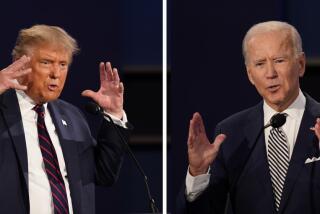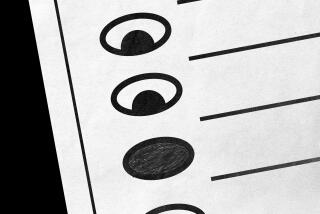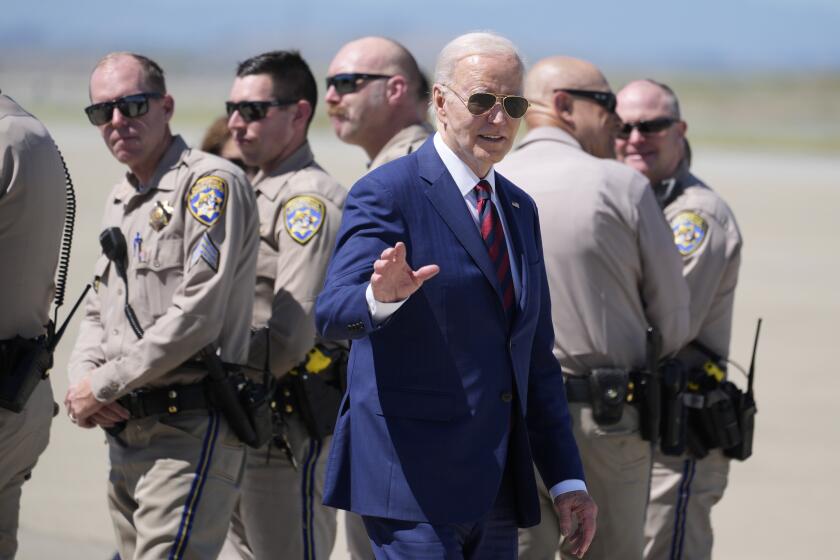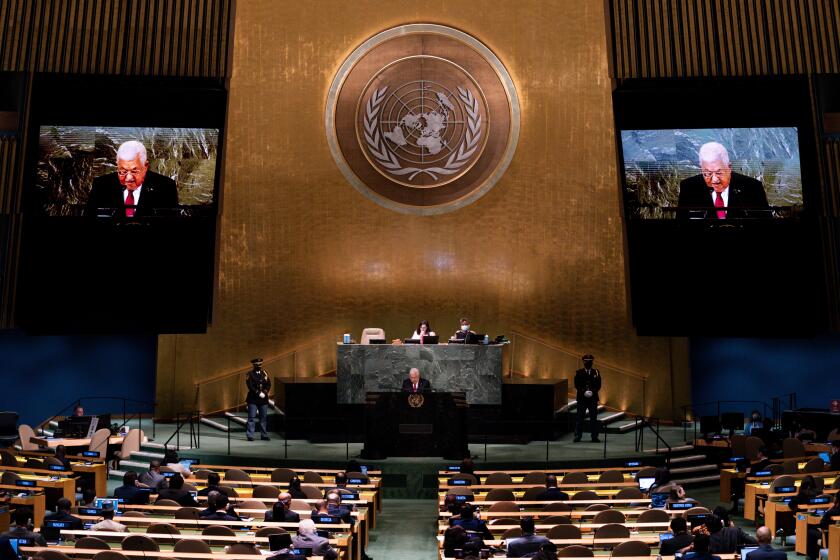How Elizabeth Warren has risen in a crowded 2020 Democratic presidential field
Only a few weeks ago, many political analysts were writing off Sen. Elizabeth Warren.
Her campaign was too much a collection of position papers, and not enough about a person, some said. She had spent too much money on staff in early states, and her decision to eschew big donors had crippled her ability to pay for it, others averred. The Massachusetts senator’s campaign seemed stuck.
Those problems still exist. But as is so often the case, the dire assessment proved premature. Thursday’s poll of California voters, done for The Times by the Berkeley Institute of Governmental Studies, provided the latest evidence that Warren is on a roll and gives a sense of where her support comes from.
Sign up for the Essential Politics newsletter »
WARREN VS. SANDERS
Warren’s rise can’t help but be at the expense of Sen. Bernie Sanders. As the two candidates at the left end of the Democratic field, they inevitably compete for many of the same voters.
That’s one reason that Rep. Alexandria Ocasio-Cortez’s potential endorsement looms large for both candidates, as Janet Hook wrote.
The new Berkeley IGS poll reveals a lot about how support for the two candidates differs in California, which will send more delegates to next year’s Democratic nominating convention than any other state.
At least for now, Warren solidly leads among the type of voters who define California liberalism. She dominates among those who define themselves as “very liberal,” getting 1 in 3 of their votes. And she leads the field among white college graduates, with 22%, edging out Joe Biden by a couple of percentage points. Sanders has only 10% of that group. Biden and Warren also share the lead among black voters, while Sanders gets only single-digit support among them.
White college-educated liberals in California are often relatively affluent, and, indeed, Warren leads among those whose taxes she’d increase — getting support from 21% of those earning $200,000 or more, again narrowly ahead of Biden. About 6 in 10 of Warren’s supporters earn $100,000 or more.
A similar picture comes from looking at the issues to which voters give priority: Warren has a big lead among those who back immediate adoption of certain criminal justice reforms, such as reducing sentences for lower-level offenses, a priority for many liberal voters.
Sanders draws a notably different profile. His backers are younger — he has a big lead among voters younger than 30, and about 4 in 10 of his supporters are younger than 50. That younger support, which is true nationwide, translates in California into backing from Latinos, especially Latinos whose main language is English — a group that is young, on average. He leads the field among that group, while Biden leads among Latinos whose main language is Spanish and among California voters who are immigrants.
Sanders also draws significantly more support from men than women, something that’s rare among Democrats. That wasn’t surprising in 2016 when he was the only challenger to Hillary Clinton. It’s more striking now. Even Pete Buttigieg, who gets strong support from gay men, has only slightly more backing from men than women, the poll found. For Sanders, it’s more lopsided: Men are a minority of likely voters in the California Democratic primary, but 54% of Sanders backers.
Sanders’ backers, on average, are also more likely than Warren’s to be blue-collar. Biden has a big lead among Democratic voters who haven’t gone to college, but Sanders comes in second, with more than twice as much support as Warren. And he leads among those who have some college education, but not a four-year degree, probably in part because of support among students.
His backers are also less affluent. Only about 4 in 10 of Sanders’ backers earn more than $100,000, compared with Warren’s 6 in 10. He leads the field among voters earning less than $40,000 a year.
He also leads among those voters who put a priority on legalizing pot.
THE SECOND CHOICE
For Sen. Kamala Harris, the poll results came as bad news -- fourth place in her home state is a problem, even if the difference between first and fourth is fairly small.
But as Warren’s experience has shown, primary campaigns often have sudden ups and downs. And the poll indicates that if other candidates falter, Harris has potential to rise.
The clearest evidence comes from looking at second choices.
Harris leads overall as a second choice for voters. In particular, she’s the second choice for both Biden and Warren supporters, cited by 28% of Biden voters and 40% of Warren’s.
One group she’s not popular with, however, are Sanders backers. Their overwhelming second choice is Warren, cited by 42%. Biden comes in next as the second choice of 20% of Sanders backers. Harris gets 17%.
DEMOCRATS PREPARE TO DEBATE
The Democratic National Committee on Thursday announced the official list of the 20 candidates who qualify for first presidential debate, which will be held over two nights, on June 26 and 27, with 10 candidates each session. Friday afternoon, NBC, which is hosting the debate, is scheduled to announce the results of the lottery to determine who will appear which night. The lineup could matter.
With 23 more-or-less serious candidates running and a self-imposed limit of 20 candidates for the debate, the DNC was bound to draw some controversy. The biggest involved the exclusion of Montana Gov. Steve Bullock, who got into the race late and barely missed the threshold of 1% support in at least three polls. Bullock may make the cut for the July debate, which, of course, would bump someone else, generating more complaints. The threshold will be twice as high for the September debate, which could force some candidates out of the race.
New York Mayor Bill de Blasio made the debate cutoff, but that’s about all that’s gone right for him, Evan Halper wrote. De Blasio has drawn heavy criticism at home for running and, so far, has attracted mostly yawns from voters elsewhere.
Even in Iowa, where voters love to be courted, some are getting tired of the huge field. Seema Mehta reported from the Cedar Rapids convention center, where 19 Democrats each got five minutes to summarize their campaign pitches in the first major cattle call of the Iowa campaign.
Biden, who skipped that event to go to his granddaughter’s high school graduation, took considerable flak for being absent. But he may have had the last laugh. Two days later, he had Democrats’ attention all to himself as he and President Trump crossed paths and split screens, campaigning across the state, focused on each other, as Eli Stokols and Hook reported.
TRUMP’S DIGITAL ADVANTAGE
Trump has a big, early lead in Facebook ads, and that deeply worries Democratic strategists, as Halper and Noah Bierman reported. The president’s reelection campaign is busy testing messages and gathering data for the general election while Democrats are tied up in their primary. That means the eventual Democratic nominee will have to play catch-up.
IMPEACHMENT DEBATE
Rep. Zoe Lofgren (D-San Jose) was a young staff member when the House considered impeaching President Nixon. She was a member of Congress during the Clinton impeachment. And, as Jennifer Haberkorn reported, she doesn’t want a third. Lofgren’s experience illustrates some of the reasons why House Democratic leaders have taken a go-slow approach to impeachment.
Another reason: As our Berkeley IGS poll showed, even in California, many Democratic voters aren’t convinced. About half of Democrats statewide think Congress should move to impeach, but the rest don’t. And among non-party voters, only about one-third favor starting the impeachment process, the poll found. And Trump’s popularity in California is far lower than it is nationwide.
Meanwhile, of course, Trump continues to give Democrats more reasons for wanting to remove him from office. The latest came in an interview with ABC’s George Stephanopoulos in which Trump said he would welcome foreign help in the 2020 election.
“I’d take it,” he said when asked how he’d respond if Russia again offered dirt on an opponent. As Stokols, Bierman and Chris Megerian reported, the remark once again fanned partisan flames.
Trump’s remark came at a time when House Democrats have been struggling for solid footing in their efforts to continue investigating Trump. As Megerian wrote, the White House has blocked most of the witnesses they have wanted to summon. This week, the best they could do was to bring John Dean to testify. As Caroline Engelmayer wrote, Dean cited parallels between Watergate and Trump’s actions, but even as theater, the hearing got little attention.
And the fight over access continued. The Justice Department and the House Judiciary Committee reached a partial deal to hand over evidence from Robert S. Mueller III’s investigation. That averted an immediate contempt fight, although the House voted to authorize going to court over subpoenas if the administration doesn’t follow through. Meanwhile, a different House committee voted to begin contempt proceedings against Atty. Gen. William Barr and Commerce Secretary Wilbur Ross for their refusal to turn over documents related to putting a question about citizenship into the 2020 census.
As Doyle McManus wrote, House Speaker Nancy Pelosi’s anti-Trump strategy is “see you in court.” She’s hopeful that a series of court decisions against the administration will strengthen the Democrats’ standing with the public. But as Engelmayer wrote, that strategy faces several problems, one of which is those court rulings could come too late to matter.
WHAT HOMELESS PROBLEM?
Homelessness is a crisis in California and many other urban centers. But the 2020 candidates are mostly ignoring it, as Tyrone Beason, Melanie Mason and Michael Finnegan wrote. There’s little political constituency to gain, and the policy issues are formidable.
That’s not true of immigration. Harris outlined a new plan this week on that issue. As Mason reported, she said she would protect “Dreamers” through executive orders if necessary.
GOODBYE SARAH
Sarah Huckabee Sanders, Trump’s White House press secretary, is stepping down. As Bierman and Stokols reported, she’s presided over the demise of the daily press briefing — none has taken place for more than three months — and confessed to Mueller’s investigators that she lied to reporters on at least one occasion. Trump tweeted that he hopes she’ll run for governor in her native Arkansas, following the path of her father, Mike Huckabee, who was governor from 1996 to 2007.
THE MEXICO DEAL
As Tracy Wilkinson wrote, U.S. and Mexican officials continue to give different accounts of the immigration deal that averted Trump’s threat to impose tariffs on Mexican imports. In earlier administrations, reporters and the public might have been inclined to give the White House version the benefit of the doubt. Under Trump, that’s disappeared.
WEEKEND READ
Set aside time to read Del Wilber’s excellent account of how a few pill mills helped fan the U.S. opioid inferno — responsible for 12 million pills and 700 deaths.
LOGISTICS
That wraps up this week. Until next time, keep track of all the developments in national politics and the Trump administration at our Politics page and on Twitter @latimespolitics.
Send your comments, suggestions and news tips to politics@latimes.com.
If you like this newsletter, tell your friends to sign up.
More to Read
Get the L.A. Times Politics newsletter
Deeply reported insights into legislation, politics and policy from Sacramento, Washington and beyond. In your inbox three times per week.
You may occasionally receive promotional content from the Los Angeles Times.







